
Thursday, April 28, 2011
Drawing Blog Thingie (Tianyu)

Saturday, April 23, 2011
DRAWING
Drawing to me is a way of exploring abstract ideas that often form in my mind. It calms my nerves. The last two years of high school, with all the SAT preparation and college applications were my most stressful and not surprisingly also my most productive where drawing was concerned. I think I filled about six 50-sheet sketchbooks. Drawings allow me an avenue to privately and quietly vent out complex emotions at times and also to just take my mind of something stressful with out having to do too much. A drawing can take me anywhere from a few seconds to complete a simple doodle or several hours to create an elaborate sketch.
I like drawing using a ballpoint on a thick ivory sheet. I like the greasy mark that the ballpoint makes on the sheet and especially enjoy creating crosshatch patterns. The feeling of the pen digging into the paper is a very satisfying one. I love how, by simply varying pressure I am able to create marks of a myriad different thicknesses. When I am writing or speaking, I often feel that there is a disconnect between the original thought and what I am able to express. This could stem from the fact that the human mind works faster than I can possibly hope to express. I feel the medium some how alters the thought in these cases, however in the case of drawing I don’t feel this disconnect I feel like the image just flows out. The best part is that when I sit down to draw I don’t have a clear idea ass to what it is I am trying to say – I don’t have to. Drawing affords us that freedom. I don’t think I can say the same for expression through speech; the result would be nonsensical word vomit. There is a reason why phrases like “Think before you speak” exist. Drawing makes no such demands.
A sketchbook is also a great way to map one’s own thoughts and incidents in one’s life. Whenever I flip through any of my sketchbooks I find it amazing how I am able to recall the moment of creation of each of the drawings. Sometimes I can recall entire scenarios that led me to create a particular drawing I made months or even years ago. It is hard to explain but it’s one of the most exciting feelings I have experienced.
Friday, April 22, 2011
FRANCIS NEWTON
SOUZA
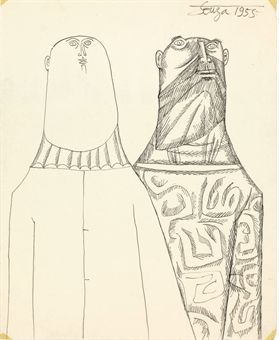
F N Souza is regarded as one of the most prolific modern artists to come out of the artistic renaissance in India that coincided with the country’s independence. Souza was born in the 1920s in an orthodox Christian family in rural Goa on the southern
 coast of India. He was initially supposed to be ordained as a priest however he was expelled from the convent where attended school after being accused of drawing pornographic images on the walls of the bathroom. He later wrote of the incident saying that he was merely correcting the bad job done by the actual per perpetrator. He later attended the Sir J.J. School of Art in Bombay but was suspended in 1945 for participating in nationalistmovements against the British government of the time. He later went on to found the Progressive Artists Group with fellow artists like M.F Hussein and S.H. Raza who would go on to become stalwarts of Indian
coast of India. He was initially supposed to be ordained as a priest however he was expelled from the convent where attended school after being accused of drawing pornographic images on the walls of the bathroom. He later wrote of the incident saying that he was merely correcting the bad job done by the actual per perpetrator. He later attended the Sir J.J. School of Art in Bombay but was suspended in 1945 for participating in nationalistmovements against the British government of the time. He later went on to found the Progressive Artists Group with fellow artists like M.F Hussein and S.H. Raza who would go on to become stalwarts of Indian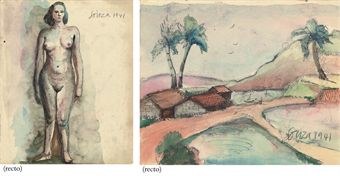 Modern Art. Though he received little appreciation during his lifetime, which was marred with episodes of bankruptcy, alcoholism, destitution and conniving gallery owners, soon after his demise in 2002 his work shot into lime light and soon occupied center stage in art auctions and exhibitions alike.He is one of the few artists who considered drawing to be an important medium of expression in itself. Because Souza had a knack of drawing from a very early age (he painted the work on the right at age 17), his body of work on paper is an extensive one. So much so that his drawings are often used to map his progress from a young energetic teenager during his formative years to the master of line that he later matured into.
Modern Art. Though he received little appreciation during his lifetime, which was marred with episodes of bankruptcy, alcoholism, destitution and conniving gallery owners, soon after his demise in 2002 his work shot into lime light and soon occupied center stage in art auctions and exhibitions alike.He is one of the few artists who considered drawing to be an important medium of expression in itself. Because Souza had a knack of drawing from a very early age (he painted the work on the right at age 17), his body of work on paper is an extensive one. So much so that his drawings are often used to map his progress from a young energetic teenager during his formative years to the master of line that he later matured into.What governed Souza’s drawing style was not how the eye perceived the surroundings but what the image felt like. For example, his numerous cityscapes and representations of mythical scenarios aren’t really representational of specific physical or geographical locations but are
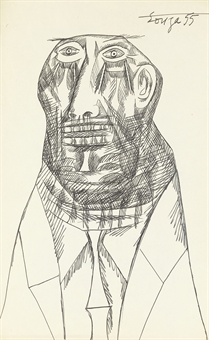 rather like the masterpiece of a 4 year old or like the robots and monsters that children draw to get through a boring class in school. They have the same perplexing quality, wherein the first impression is that the drawing is definitely representationally inaccurate but as we give it a second look we realize the different dimensions that are encapsulated in the work.
rather like the masterpiece of a 4 year old or like the robots and monsters that children draw to get through a boring class in school. They have the same perplexing quality, wherein the first impression is that the drawing is definitely representationally inaccurate but as we give it a second look we realize the different dimensions that are encapsulated in the work.His drawings are often of a mathematical nature, in the sense that you feel that there is a pattern. It is as if he decided to draw something but decided to do so using a particular process. I feel it is similar to the way Picasso drew from observation but he put the image through a cubist “process” or the way Seurat put his images through a pointillist “process”.
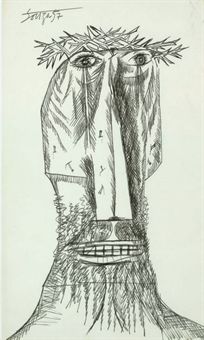
His early work can be seen to be influenced by his beautiful surroundings in lush Goa and seem also to derive a lot of imagery from Christian iconography prevalent in the region. He often returned to these themes and later ventures into Hindu iconography. His favorite subject however – one which he would return to throughout his career would have to be – The Human Head. His fascination with the human head was a truly remarkable one. Right from his early portraits to his heavily worked masterpieces from his mature period, Souza’s heads were what dominated his creations.
Other than simple drawing with pen or pencil on paper, Souza developed a unique method of working using magazine paper. He would use acid or other chemicals to dissolve the bright pigments used to print magazines and use them to draw images. These images often seem urgent rushed and forceful as the pigments could only remain fluid for a few minutes at a time - thus he had to be quick with his brush strokes. Even though he developed this technique over 5 decades ago, it remains unique to him.
Alicia Li- Art Reflection
I’ve never taken a class at school so this was definitely a new experience. In high school, I changed art tutors and began drawing more rigorously for three or four hours every Saturday, one-on-one with my teacher. Thus, being in a class setting was hard to adjust to at first. I have also become used to working on an assignment over a few weeks, or even months (for some oil paintings) so I had a rough time coming up with new things to draw every week and only spending one week for each assignment. I think this class has definitely helped me become more creative. Before, the only drawings I’d do were the stereotypical violin or portrait of friends and family members.
My favorite art medium has always been charcoal. Some people find that weird because charcoal isn’t colorful and it’s dirty and messy to work with. But I love how graceful and sophisticated charcoal looks across the page. Charcoal has a beautiful, polished look when used correctly.
Besides charcoal drawing, I really enjoy Chinese ink and brush painting. I dabbled in it a bit with a second art teacher who only taught Chinese brush painting. Chinese painting is very different from western art because it’s so impulsive. In fact, my mother initially brought me to learn the technique because she thought I needed to get more “gusty” when I drew or painted. I have always been super meticulous and soft-handed when it came to drawing or painting. The thing with ink is…once it’s on paper, it’s not coming off. Go big or go home.
Thursday, April 21, 2011
Reflections on Drawing - Christy Kim
When I chose to
 come to Duke, I came with the mindset that I was going to pre-med, majoring in a science-related field. When I told my parents that I had enrolled in a drawing course for Spring semester, they were very alarmed at first. In high school, I had spent and devoted a significant chunk of my time to art, which frequently (if not always) interfered with my academics. They hoped that I would not continue art in college because they were afraid of the same occurrence. Although I did devote a significant amount of time to this course this semester, I was able to balance it successfully with all of my studies. Drawing assignments and sketchbook assignments, in particular, played an integral part in being a stress outlet and creativity stimuli.I showed my parents that an art course can not only be beneficial to my studies but also confirm my passion for visual arts. Having taken this class, I can fervently say that I would be ecstatic about pursuing a career in visual arts. Now, I have officially decided on visual arts as my prospective major.
come to Duke, I came with the mindset that I was going to pre-med, majoring in a science-related field. When I told my parents that I had enrolled in a drawing course for Spring semester, they were very alarmed at first. In high school, I had spent and devoted a significant chunk of my time to art, which frequently (if not always) interfered with my academics. They hoped that I would not continue art in college because they were afraid of the same occurrence. Although I did devote a significant amount of time to this course this semester, I was able to balance it successfully with all of my studies. Drawing assignments and sketchbook assignments, in particular, played an integral part in being a stress outlet and creativity stimuli.I showed my parents that an art course can not only be beneficial to my studies but also confirm my passion for visual arts. Having taken this class, I can fervently say that I would be ecstatic about pursuing a career in visual arts. Now, I have officially decided on visual arts as my prospective major.
Fitz: Art and Murdoch
Art – in all of its various forms – has intrigued me from a very young age. My parents bought me a plethora of sketchbooks, colored pencils, paint and more. They encouraged me to bring my sketchbooks wherever we went, even out to dinner at nice restaurants. Throughout middle school I was surrounded by supportive and encouraging art teachers and even spent a summer taking art lessons from a local painter. When I reached high school, however, soccer had begun to take up a significant amount of my time as I played both for a travel team and my Regional ODP team. I had just enough time to get my schoolwork done after practice and not much time for anything else. With art on the backburner, I filled this void with doodling. I became an avid doodler, drawing on almost every page of notes, the fronts and backs of binders and on any scrap piece of paper I could find. Sadly enough, I have not seriously drawn (as we have this semester) since my 8th grade art class, a class focused more on painting than actual sketch work. While I am incredibly glad that I took this class, it pointed out to me the many weakness in my fundamental technique. I passed up opportunities to take art classes in high school and my earlier college years to commit myself fully to soccer. Looking back on these decisions I would not change a thing. I have the rest of my life to pursue my passion for art and relearn the techniques and skills that I have neglected for all of these years. During this semester alone I have gained more knowledge about drawing than I have in the past 21 years of my life. One of the most important lessons I have taken away from this class is the importance of practice, patience and time commitment. It is difficult to produce a quality piece of art when you begin working on it the night before it is due! All in all, this past semester was an eye-opening experience that will only encourage me to continue working hard and to absorb the wealth of knowledge around me.
For the past year I have been working closely with the philosophical writings of Iris Murdoch. My independent study focuses specifically on Murdoch’s philosophy of art. Art, she believes, has a unique ability to reveal without explaining. It is a universal language, a portal to the Truth and Beauty that lies beyond the basic understanding of man. I wholeheartedly agree with Ms. Murdoch. My work with her writings is one of the factors that encouraged me to take this class. Art is a physical instantiation of thought. It is the closest thing, I believe, to being able to see into the mind of another person. Whether that be in the form of literature, painting, music, drawing or dance, art reveals to us something true and real about ourselves and the world we inhabit. In one of Murdoch’s philosophical works, The Sovereignty of Good, she compares art to morals, saying that both require a disciplined eye and an ability to distinguish fantasy (“I like it”) from reality (“there it is”). This, to me, is the definition of great art – a work that strikes me and moves me and causes me to reevaluate the current “reality” that I see. As I go forward, I hope to build upon what I have learned here so that I may better express myself to others and continue to expose myself to art in every way possible.
Thoughts on Drawing
I "graduated" from art school when I was fourteen and could not imagine picking up a drawing tool ever again. However, as time went on, I found myself returning to a stack of my old works more and more often. Once in a while, I'd even get an urge to draw my mom lying on a couch with our cat in her lap. With time, those urges started coming more frequently. I would never spend more than half an hour on a drawing - I did not care about it being 'polished' - I'd always leave it in the "sketch" shape. What I enjoyed about sketching is how liberal one can be with the line - how a seemingly careless style can produce a drawing that is dynamic, full of character and life.
Take a look at this example of still life by Cezanne - one of my favorite pieces of his
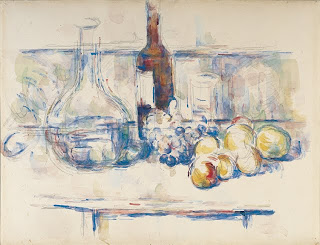
Paul Cézanne
French, 1906
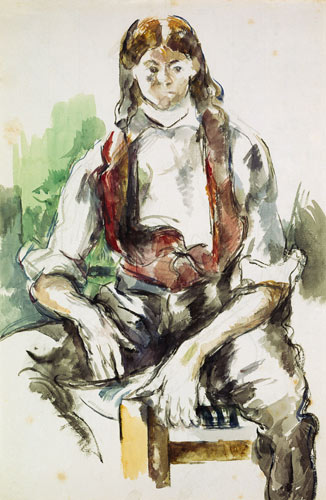
Paul Cézanne
Simple, yet deep, real.
I never worked on tiny details either or paid an extra effort to staying within the contours of figures when I created shadows or put in a darker value.
I began to realize that what I hated about art school was not the art of drawing itself, but how methodical my lessons made it seem. I hated that I had to come to school every day at 3 pm and spend 3 to 4 hours drawing, no matter whether I felt like it or not. Weeks, sometimes months would be spent on the same composition, same drawing, trying to get it to that ever-unreachable state of perfection.
Sketching requires none of that. Furthermore, to me, the beauty of sketches lies in their imperfections. Sketches can be as easily abandoned as they are started. They don't need to be about anything, don't need to have any meaning, any story behind them.
I find joy in these short bursts of creativity; even today, sitting in my partial differential equations lecture, i mindlessly sketched my professor writing something on the board. Yes, the drawing was in pen, on a ruled paper, it turned out messy, but I loved it a lot. If you rummage through my room, you'll find quite a few sketched I made of my boyfriend on all types of paper, in all sorts of media.. I think I even drew something on a paper coffee cup at some point!
Drawing 100 gave me a great excuse to take a well-deserved break from endless equations and immerse in sketching and drawing. It did turn out to be a bit more than just drawing. Coming up with a narrative for my work was probably my least favorite part of the course, since I never try to say anything with my sketches. I draw because I want to. In my sketchbook I have silly drawings of flip-flops and a recycling basket, a chair in the Math Building library. They are stupid, pointless, unnecessary, but I liked making them. That little amount of creativity I have in me all goes into putting an especially messy line on a piece of paper.
More importantly, the class got me to give charcoal another try. Having failed at it earlier, I held quite a biased opinion against using it in my drawings. However, now that I see how different and real sketches made in charcoal are, I'm sure I won't be throwing my compressed charcoal away when the semester is over.
For many, sketching is something you do right before drawing the main product - we've seen that in our course. Drawing 100 helped me realize that to me, the sketchbook is where it is all at. And I'm not getting rid of mine any time soon! See you in Figure Drawing!
P.S. Here are some beautiful sketches from a handful of the greatest artists ...

East Bergholt Church
Sketches from John Constable's sketchbook from 1814
Danwei Wu
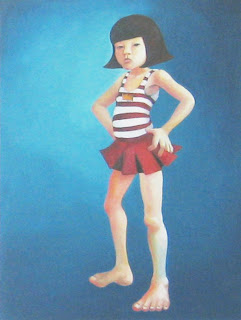
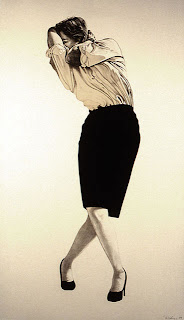
Reflections on Drawing - Nafeesa Jafferjee
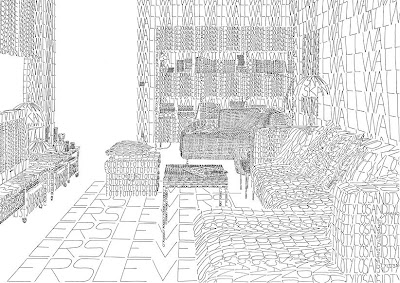


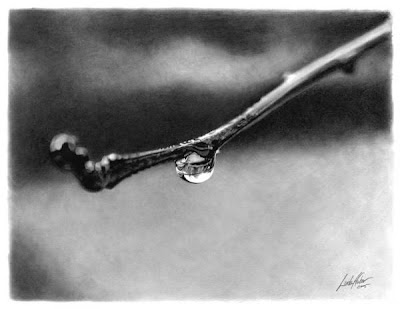 The class also led me to open my eyes around Duke. At the beginning I was frustrated drawing objects in my room, but the moment we started focusing on larger spaces, I gained a lot of knowledge on how to draw different perspectives of an open space. I had never drawn such huge spaces from observation before and so it was a challenge, but was one I really enjoyed. I particularly enjoyed the last project, where I worked under the BC plaza and was approached by many Duke employees instead of students. It was really interesting to hear their comments and fascination about the work I was doing. I felt the people I met also helped add a personality to my drawing.
The class also led me to open my eyes around Duke. At the beginning I was frustrated drawing objects in my room, but the moment we started focusing on larger spaces, I gained a lot of knowledge on how to draw different perspectives of an open space. I had never drawn such huge spaces from observation before and so it was a challenge, but was one I really enjoyed. I particularly enjoyed the last project, where I worked under the BC plaza and was approached by many Duke employees instead of students. It was really interesting to hear their comments and fascination about the work I was doing. I felt the people I met also helped add a personality to my drawing. 
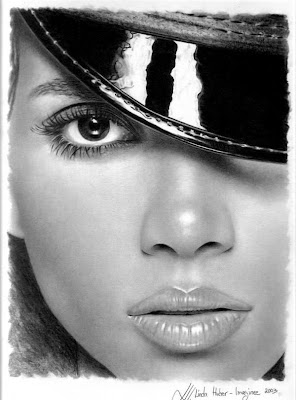
Thoughts on Drawing - Lauren Acampora

I have also been exposed to many new concepts in this class, one being the idea of negative space. I found our negative space assignment especially helpful as I struggled to accurately draw scenes in which several objects “overlap”. By focusing on the outline and shape of spaces where there was a lack of objects, I was able to much better portray the way that the objects were situated in the space in relation to one-another. Creating study drawings before beginning my assignments was also a foreign idea to me; this exercise was extremely helpful, as it forced me to take notice of any fundamental flaws in the setup of my drawing before I had invested much time into shading and detail. Another thing that I had never done before was to create a drawing from a combination of both observation and integrated photographic elements; though I have tried drawing from observation and drawing from photographs before, I had never before utilized both methods in the same composition. This was somewhat challenging for me, as I struggled to make the elements of the drawing which were taken from photographs look as if they truly belonged in the image. I was unsure of where to place any shadows as I attempted to insert objects into the pictorial space of my piece, and often failed to make objects an appropriate size. However, I still found these assignments very enjoyable, and I learned a lot from them about the communication of a narrative through drawing.
There remain many aspects of the art of drawing that our class was not able to cover, which I wish I had been able to learn more about. For example, I hope to learn more about drawing the human form. I have not had much experience with drawing people, but hope to explore portraiture and figure drawing in the semesters to come. I would also like to spend more time exploring other mediums of drawing besides pencil and charcoal. For example, would like to experiment with pen and ink drawings, stipple drawings, and pastel drawings.
One of the things that I love about the drawing is its versatility; there are a wide variety of different techniques that can be used to represent the same image. The images below are works created by artists whom I find inspirational, as they demonstrate several diverse forms that the art of drawing can take:
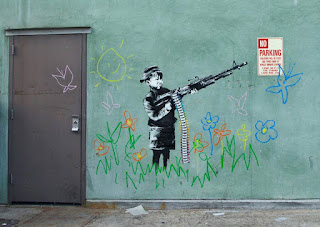

My Drawing History

I began drawing with my mom at a young age. We did all kinds of crafts together, and she encouraged me to draw whenever I wanted to (which was often). My mom is artistically inclined and considered going to art school. Now she uses her interest in art in watercolor classes at our local community center. Her interest sparked mine, and I continued art in school.
When I was twelve, I took drawing classes with the mother of one of my friends who was an art teacher and artist. I loved the classes, and to my own surprise from those sessions I produced a rather life-like self-portrait. In the class we also did contour drawings, shading (all different techniques), still life drawing, and landscapes. I remember enjoying the challenge but also feeling discouraged at times when my work did not come out the way I wanted it to. I loved drawing fictional things from my imagination mostly, drawing from real life was always frustrating. This art class would be my last investment in drawing until Drawing 100 at Duke.
In high school I stopped drawing almost entirely because our curriculum demanded that each student pursue only one “art”, and my choice was music. Further, during my first three years at Duke I did not have time to devote to drawing because I had to take so many classes to fill my major and other requirements. However, I have greatly enjoyed coming back to drawing in class this semester, and I am happy that my interest and ability have not disappeared completely.
Additionally, I have also greatly enjoyed using charcoal as a medium. I like the effects it can produce, especially when depicting this such as fur, trees, hair, and shadows. In my future with drawing, I hope to develop more feeling and interest in my drawings. I admire the work of drawing artists who can convey feelings, stories, and humor through only a few figures. For example, Kenneth Koskela (see image) often has very animated drawings. Although most of his drawings are fictional and not drawn from observation, I like the way his organization and depiction invites the viewer to look at each part of the picture, and in doing so the viewer notices the details Koskela has added.
· http://longbranchgallery.bizland.com/store/page15.html
Tuesday, April 19, 2011
Drawing Reflection: Ann Niou
One project I particularly enjoyed was the subtractive drawing project. Using the eraser as a tool for constructing my drawing allowed me to see light and shading from a new and different perspective. I liked the sense of carving away elements in order to better define my drawing.
From this class, I am beginning to learn and understand how to compose drawings in a way that conveys a narrative. What makes a piece of art good is its ability to tell a story and evoke some kind of emotion from the viewer. From our last couple of projects, I realized how differently each person can interpret a drawing and how much what you decide to put in your drawing affects the image you are trying to portray. From a technical perspective, the last two projects made me think about all of the elements that contribute to making a drawing look realistic. For examples, since we had to take images from pictures, I was forced to think about where shadows were to be placed when integrating the photos since each photo was different.
An artist that I admire who, in particular, must think about similar aspects (shading, perspective, scale, etc.) on a much different and more complex level is Julian Beever. He is known for his street artist who uses a technique called anamorphosis to create drawings that look 3-D when viewed from a particular angle:
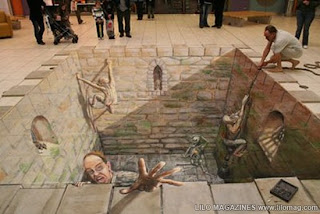
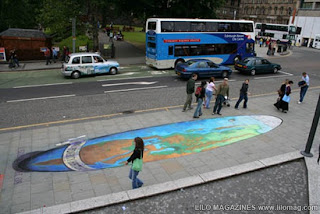

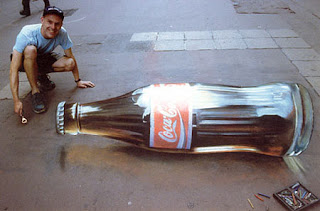

Monday, April 18, 2011
thoughts on drawing: amanda jordan
The primary objective of this class will be to familiarize students with the practice of drawing. We will explore drawing media and study the processes and techniques used by drawing masters throughout history. Even though the class will focus on fundamentals, experimental and imaginative expression will be explored in the second half of the semester...
Charles Blanc, one-time editor of the École des Beaux Arts in Paris,...provides a traditional and conservative definition of drawing: ...drawing is not a simple imitation, a copy corresponding mathematically to the original, an art reproduction, a pleonasm. Drawing is a work of the mind, as is indicated by the orthography of our fathers, who wrote it dessein-design. Every drawing is the expression of a thought or a sentiment, and is charged to show us something superior to the apparent truth...
Drawing, properly taught, is the best way of developing intelligence and forming judgement, for one learns to see, and seeing is knowledge.
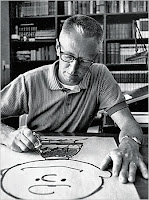
For now I am possibly going to explore more literature of that sort, continuing to apply what I have learned in class, and take more courses in the Visual Arts department. Charcoal was quite a challenge, so maybe I'll continue working with that to make sure I don't sacrifice detail for expression, as I sometimes seem to do when using charcoal. However, above all, for me the course synopsis accomplished exactly what it says. In the future though, I would really like to explore animation, like the late great Charles Schulz. I am going to try to keep sketching and bringing my book with me while traveling this summer and next year so that I can have some sort of visual journal, as in the pictures below, to document what I see and think.
Drawing (blog assignment 2)
I liked drawing Duke’s architecture. I like realistic drawings, but I always want what I draw to be significant to me; I want it to be something I could hang in my house and no one would wonder, “Why did she hang that? That has nothing to do with her.” And since I love Duke so much, my drawings of the campus are important to me, and I spent more time on them and took more pride in them because I was representing something that I really love.
One of my favorite artists from home is named Len Upin. He used to teach at my high school before I was a student there, but he came back once a year for Arts Fest and displayed some of his works. I really like his portraits because he incorporates the people’s personalities into the drawings by focusing on facial expressions. Here is a link to some of his works.
Sunday, April 17, 2011
Thoughts on Drawing by Ingrid Zhuang
Relating to the first blog post, I focused on Rubens’ sketch of "Le Jardin d'Amour".
“I was amazed by it; as not only did I simply find it beautiful, I found it impressive that he used the technique of sketching the work in relatively high detail but leave the face of the girl in profile as nothing but an outlined space. The perfect composition of negative and positive space was so innovative (at that time period) as well as pleasing. “
Like Rubens, I also like to work with composing positive and negative spaces. In my opinion, negative space sometimes conveys more meaning than what I’m actually drawing. It is not simply a “background” in the composition, but plays an active part in expressing the unconscious side or the conscious side when intentionally focused on creating the negative space.
One of the world’s most famous graphic artists, Maurits Cornelis Escher (1898-1972) inspired my interest in paying special attention to the negative space in my drawings. Although his work are mainly woodcuts and lithographs, Escher’s impossible structures, (such as Ascending and Descending, Relativity, his Transformation Prints, such as Metamorphosis I, Metamorphosis II and Metamorphosis III, Sky & Water I or Reptiles), embody techniques that could be applied to drawing. Escher’s work draws the viewers into layered and endless loops, which elevate them to nth dimensions. Shapes craftily mingled in patterns and perspectives seamlessly knitted in a whole. His work is so rich and simply calling them “optical illusions” could not do them justice.
Below are some images of Escher’s work.
I also tried to mimic his style once; it was very difficult.
I have attached my piece "Elephants & Doves" at the end for people’s entertainment.





















